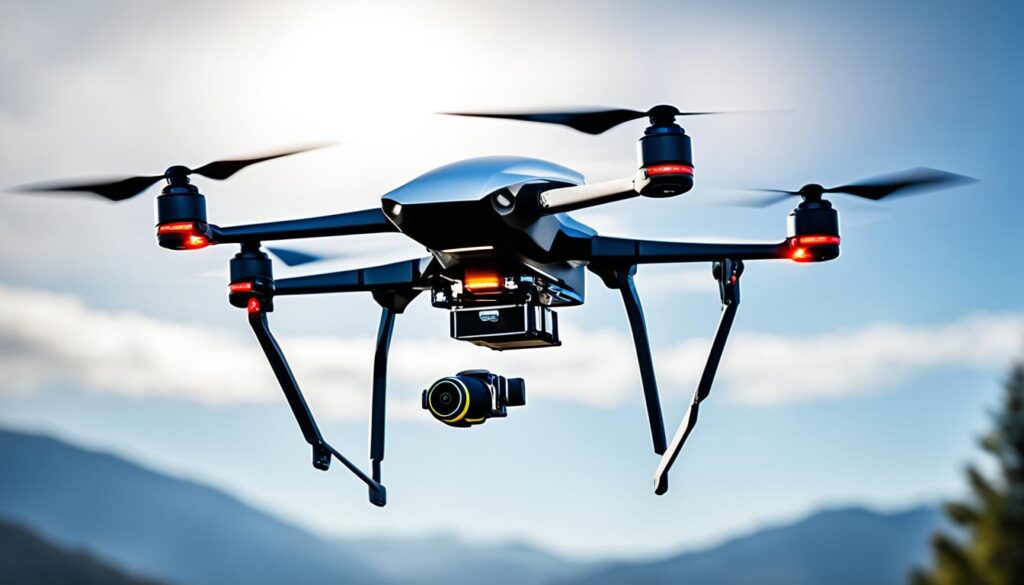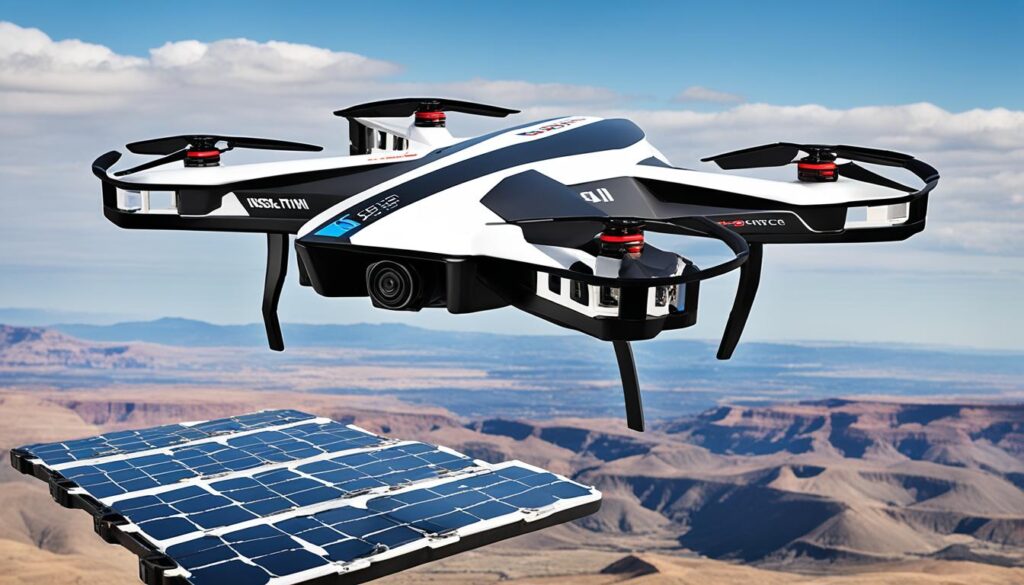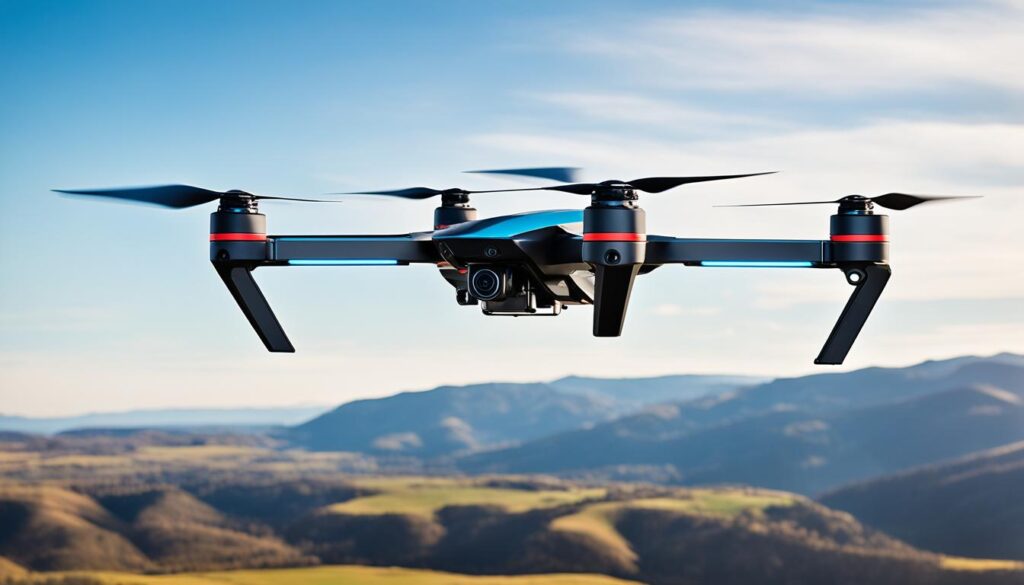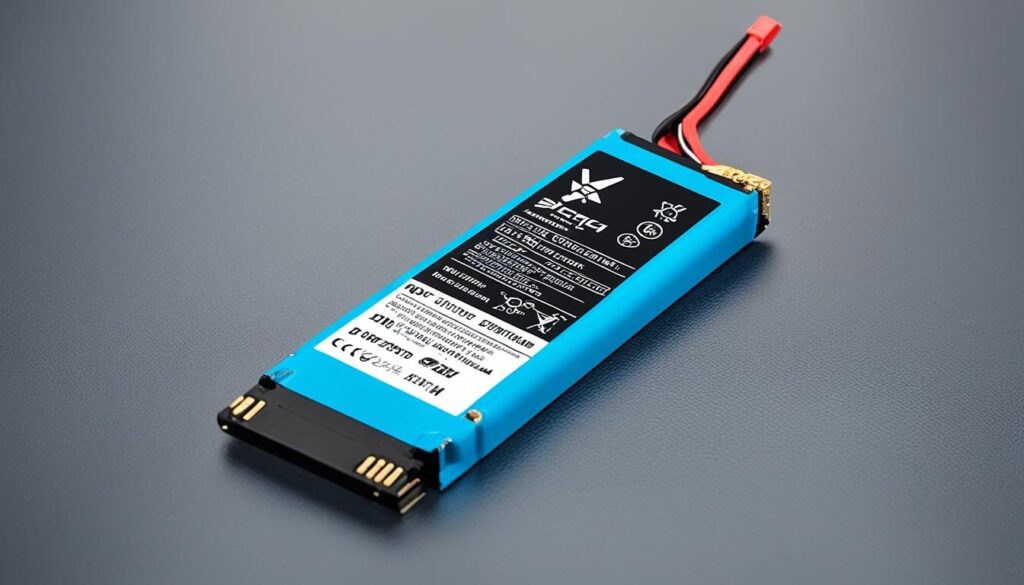Lightweight polymer lithium-ion battery for Drone or UAV
The rise in the usage of drones and unmanned aerial vehicles (UAVs) has sparked the need for better battery technology. A prime example of such innovation is the development of lightweight polymer lithium-ion batteries. These batteries are crafted for drones and UAVs to ensure optimal performance.
Traditional lithium-ion batteries tend to be bulky and add unnecessary weight. However, lightweight polymer lithium-ion batteries utilize cutting-edge polymer materials. This change significantly reduces weight without sacrificing performance or dependability. For drones and UAVs, these batteries mean longer flight times, enhanced agility, and increased longevity.
Key Takeaways:
- Lightweight polymer lithium-ion batteries are tailor-made for drones and UAVs, offering a lighter weight compared to traditional batteries.
- They enhance flight duration, maneuverability, and lifespan for drones and UAVs.
- Amicell Energy Systems Design & Manufacturing specializes in custom lightweight battery packs suited for various drone uses.
- These batteries play a crucial role in improving drones and UAVs’ performance and efficiency.
- Future drone battery innovation, including solid-state lithium technology, promises to revolutionize how drones are powered.
The Advantages of a lightweight battery for Drones and UAVs
Using a lightweight battery can greatly boost drone and UAV performance. Lightweight batteries allow for longer flights, better agility, and more durability. Drone operators can achieve exceptional flight lengths, maneuver easily, and enjoy an increased lifespan of their aircraft.
Enhancing Flight Duration with High Power Density
Lightweight batteries provide drones with longer airtime due to high power density. This means they pack a lot of energy into a compact, light form. The impressive power-to-weight ratio ensures drones can fly longer, boosting efficiency and productivity in various tasks.
Significant Weight Reduction for Improved Maneuverability
One major benefit of lightweight batteries is the reduction in drone weight. Less weight means drones can move more swiftly and precisely. With better maneuverability, drones excel in tight spaces and complex operations, making them crucial in diverse fields.
Extended Lifespan with Long Cycle Batteries
Lightweight batteries also mean drones last longer due to enduring charge cycles. They are built to last many charges without losing performance. This reliability and cost-effectiveness enhance operational efficiency and lower maintenance expenses over time.
A Comparative Table: Types of Drone Batteries
| Battery Type | Power Density | Weight Reduction | Long Cycle Capabilities |
|---|---|---|---|
| Lightweight Polymer Lithium-ion Battery | High | Significant | Yes |
| Traditional Lithium-ion Battery | Moderate | Limited | No |
| Nickel-Cadmium Battery | Low | Minimal | No |
The table above contrasts lightweight polymer lithium-ion batteries with traditional types. The lightweight option gives higher power, substantial weight savings, and superior cycle life. It stands as the superior choice for drone and UAV operations.
Innovative Battery Technology: Polymer vs Traditional Li-ion
In the drone and UAV sphere, battery choice is vital for performance, efficiency, and safety. Polymer batteries and traditional lithium-ion batteries are two key options. We will examine the differences and benefits of these battery technologies.
Comparing Energy Densities: Polymer Ahead of the Curve
One major benefit of polymer batteries is their superior energy density over traditional lithium-ion batteries. This allows for a longer-lasting power supply without the added weight. Consequently, drones with polymer batteries can fly longer, enhancing operations like aerial photography and mapping.
For instance, a 3000mAh polymer battery could deliver as much power as a 3500mAh lithium-ion battery. This results in lighter drones with longer flight times. This advantage enables operators to cover more ground or undertake prolonged missions.
Amicell Energy Systems Design & Manufacturing, a reputable industry manufacturer, produces lightweight polymer batteries with high energy density. These batteries surpass traditional lithium-ion options.
Addressing Safety: The Stability of Polymer Batteries
Safety is crucial when selecting a battery for drones and UAVs. Polymer batteries offer improved stability and safety over traditional lithium-ion batteries.
These batteries are less likely to experience thermal runaway, which can cause fires or explosions. This safety feature makes polymer batteries a dependable option for UAVs, where reliability is essential.
The stability of polymer batteries comes from their construction. They use a solid-state electrolyte and solid polymer composite, increasing thermal stability and reducing short circuit risks.
Amicell Energy Systems Design & Manufacturing ensures high safety by following strict quality controls. They comply with international safety standards in making polymer batteries.

Custom UAV Battery Solutions for Specific Applications
Drone and UAV users have diverse needs, prompting manufacturers to offer custom battery solutions. These are tailored to meet the precise demands of various drone systems. They ensure drones operate at peak performance and efficiency.
Amicell Energy Systems Design & Manufacturing excels in crafting targeted UAV battery solutions. Their focus spans several industries, including agriculture spraying, mapping, aerial photography, and cargo transportation.
Having a customized UAV battery can greatly enhance drone application effectiveness. For example, agricultural drones need batteries designed for extensive use and heavy lifting. Meanwhile, aerial photography and mapping drones require batteries that balance flight time with minimal weight.
Amicell Energy Systems Design & Manufacturing caters to these precise needs with their custom UAV battery solutions. They create batteries that offer the necessary power and longevity. This ensures drone systems work effectively, even in challenging conditions.
| Industry/Application | Battery Solution |
|---|---|
| Agriculture Spraying | High-capacity batteries with extended flight duration and heavy payload capabilities. |
| Aerial Photography | Lightweight batteries with a balance between flight duration and weight for extended photo and video capture. |
| Mapping | Batteries optimized for long flight missions and precise data collection. |
| Cargo Transportation | High-capacity batteries with long flight duration and stability for transporting heavy loads. |
Opting for a custom UAV battery solution means the drone’s power system is precisely tuned. This results in superior performance, extended flight durations, and overall enhanced efficiency.
Understanding the Li-ion Battery BMS for Drones
A Li-ion battery BMS, or battery management system, is crucial for drone battery safety and efficiency. It monitors voltage, current, and temperature, maintaining operations within safe confines. This prevents overcharging or overheating, averting potential damage.
This system acts as a protective barrier for both battery and drone. By keeping an eye on battery parameters, the BMS can determine its state of charge and health. This allows drone operators to make smart choices about battery use and upkeep.

“The Li-ion battery BMS ensures the longevity and reliability of drone battery packs, providing peace of mind to drone operators.” – Amicell Energy Systems Design & Manufacturing
For drone operators, understanding the Li-ion battery BMS is fundamental. It helps extend the life and reliability of battery packs. Through a deep grasp of BMS intricacies, operators can enhance battery charging, avert damage, and boost battery life.
Drone battery management systems offer detailed monitoring and diagnostics. This enables operators to quickly spot and address potential issues. Such a forward-thinking approach to battery care reduces the chance of failures during flight, ensuring safer and more reliable drone usage.
| Benefits of Li-ion Battery BMS for Drones |
|---|
| 1. Enhanced safety: The BMS prevents overcharging, over-discharging, and overheating, safeguarding the battery and the drone from potential accidents or damage. |
| 2. Improved battery lifespan: By monitoring and controlling the battery’s operating conditions, the BMS ensures optimal battery performance and longevity. |
| 3. Accurate battery monitoring: The BMS offers real-time information about the battery’s state of charge, health, and remaining capacity, enabling operators to make informed decisions during flights. |
| 4. Advanced diagnostics: The BMS provides detailed diagnostics, allowing operators to detect potential battery issues early on and take the necessary actions to prevent battery failure. |
The Li-ion battery BMS is a key part of contemporary drone battery tech. It plays a pivotal role in keeping drone batteries safe and efficient. Through this, the BMS boosts drones’ overall performance, reliability, and service life.
Maximizing Quadcopter Performance with Lightweight Power Packs
Quadcopters stand out for drone lovers due to their flexibility and agility in flight. Essential for boosting quadcopters’ efficacy are lightweight power packs. These specially crafted batteries ensure the aircraft soar high.
Lightweight power packs offer the key advantage of enhanced power delivery. Crafted for efficiency, these batteries ensure optimal energy flow to the quadcopter. This results in faster speeds, greater agility, and heightened responsiveness. Such improvements make for a superior flying experience.
Another significant benefit is the extension of flight times. Lighter batteries mean quadcopters carry less weight, staying aloft longer. This is crucial for aerial photography and videography, where extended flight times capture the ideal shots.
Furthermore, lightweight power packs improve quadcopter maneuverability. The battery’s reduced mass translates to precise control and fluid movement in the air. This enables pilots to execute complex stunts and navigate demanding courses with remarkable performance.
With growing quadcopter demand, both enthusiasts and professionals aim to elevate their drones’ capabilities. Selecting lightweight power packs designed for quadcopters unlocks their full potential. Users then enjoy superior performance, longer flights, and enhanced control.
Demystifying the Specifications: Decoding Battery Jargon
Battery specs can seem complex, yet grasping them is key for picking the right drone battery. We will delve into capacity ratings and discharge rates to guide your selection process.
Navigating Capacity Ratings: Matching Drone Requirements
Capacity ratings reveal a battery’s energy storage. They are critical for drone flight time. A battery with a higher rating holds more energy, which translates to longer flights. Match your drone’s power needs with the battery’s capacity for best results.
If your drone demands more energy for lengthy flights, choose a battery with a higher capacity. Conversely, simpler drones with lower energy needs might do well with a lower capacity battery.
However, remember that higher capacity batteries can add weight to your drone. Balancing capacity and weight is essential for the performance you aim for.
Decoding the Discharge Rates: Ensuring Reliable Power Supply
Discharge rates show how fast a battery can power drone components. This knowledge is vital for a consistent flight power supply.
Drones needing quick power bursts benefit from batteries with high discharge rates. This need arises during takeoff or abrupt maneuvers. However, drones with steady operation might need lower discharge rates.
Factor in your drone’s components, like motors and controls, when picking a battery. The chosen battery’s discharge rate must meet these demands to avoid power issues mid-flight.
By comprehending capacity ratings and discharge rates, you’ll navigate battery specs more smoothly. Selecting batteries that match your drone’s needs and ensuring the right discharge rate guarantees a stable power flow and enhanced performance.
The Environmental Impact of Lithium-ion Batteries in the UAV Sector
The use of lithium-ion batteries in the UAV sector is growing, sparking debate about their environmental impact. As drones become more popular, focusing on the sustainability of their batteries is crucial. This includes how they are made and the importance of recycling and reuse.
Adopting Sustainable Practices in Battery Manufacturing
Battery manufacturers are now focusing on sustainable practices in producing lithium-ion batteries. They aim to lessen their environmental footprints significantly. A primary strategy involves utilizing eco-friendly materials for battery production. These materials aim to decrease the need for non-renewable resources, leading to a greener manufacturing process.
Moreover, improving the efficiency of manufacturing processes is vital. By doing so, they aim to reduce energy use and cut down on waste. Battery makers are introducing methods that save resources and lower emissions during production. These steps are crucial in reducing the lithium-ion batteries’ environmental impacts in the UAV industry.
The Role of Recycling and Reusability in UAV Batteries
Recycling and reusing UAV batteries is critical to minimizing their environmental impact and encouraging a circular economy. Properly disposing of and recycling batteries allows for the extraction of important materials like lithium. These materials can be reused, decreasing the need for new raw materials and lessening the environmental load.
Battery reusability not only prolongs their life but also curbs the production of new ones. Efficient battery management and reusability practices can drastically cut electronic waste. Hence, drone operators and makers contribute to a greener UAV sector.
In conclusion, the rising use of lithium-ion batteries in drones poses environmental challenges. Nonetheless, the sector is embracing green manufacturing techniques and prioritizing recycling and reusability. These efforts are designed to reduce the environmental footprint and secure the future of lithium-ion batteries in UAVs.
The Future of Drone Battery Packs: Trends and Innovations
Continuous advancements in battery technology shape the future of drone battery packs. As drones become more integral in various sectors, the demand for stronger, more efficient batteries grows. Developers are focusing on solid-state lithium technology and battery management systems improvements. These areas are key to meeting the high performance requirements of UAVs.
Exploring Solid State Lithium Technology for UAVs
Solid-state lithium technology holds great promise for UAVs. Unlike traditional lithium-ion batteries with a liquid electrolyte, these utilize a solid electrolyte. This change boosts energy density, allowing for more energy in a compact, lightweight form. Consequently, drones can achieve longer flight durations.
Beyond energy density, solid-state batteries offer better safety features. The solid electrolyte prevents leaks and thermal runaway, making UAVs safer and more dependable. Additionally, these batteries last longer than conventional ones, making them more cost-effective over time.

Advancements in Energy Storage and Battery Management Systems
Drone battery packs improve as energy storage technologies advance. Researchers aim to increase batteries’ power density and energy efficiency. Such enhancements enable heavier payloads and extended flight times.
Battery management systems (BMS) are vital for battery performance and safety. They monitor voltage, current, and temperature to maintain safe operation. BMS improvements are crucial for more efficient, reliable drone batteries. They ensure a smoother, safer flying experience.
Taken together, the advances in energy storage solutions and BMS technology signify a bright future for drone battery packs. These developments lead to more effective, reliable UAV power sources. They support longer flight times, better performance, and greater drone capabilities.
Comparison of Solid-State Lithium Batteries and Traditional Lithium-Ion Batteries
| Battery Type | Energy Density | Safety | Lifespan |
|---|---|---|---|
| Solid-State Lithium Batteries | Higher energy density | Improved safety, eliminates risk of leakage or thermal runaway | Longer lifespan, reduces frequency of replacements |
| Traditional Lithium-Ion Batteries | Lower energy density | Potential for leakage and thermal runaway | Shorter lifespan, may require more frequent replacements |
Conclusion
Lightweight polymer lithium-ion batteries have dramatically changed the drone and UAV industry. These batteries allow for longer flights, better control, and longer life spans. This marks a significant shift from traditional lithium-ion batteries.
Developments in battery technology, specifically polymer batteries, play a crucial role in the evolution of drone battery packs. These advancements lead to batteries with higher energy densities. This means drones can now fly longer without the need for heavy batteries.
The increasing use of drones and UAVs boosts the demand for cutting-edge battery technology. Companies like Amicell Energy Systems Design & Manufacturing offer bespoke UAV battery solutions. They meet the varied requirements of different sectors.
Adopting lightweight polymer lithium-ion batteries and staying ahead of innovations allows drone users to maximize their aircraft’s potential. This leads to superior performance and broadens the capabilities of UAVs.
FAQ
What is a lightweight polymer lithium-ion battery?
A lightweight polymer lithium-ion battery is an advanced technology for drones and UAVs. Polymer materials make these batteries lighter than traditional ones.
What are the advantages of using lightweight batteries in drones and UAVs?
Lightweight batteries in drones and UAVs offer improved flight time and maneuverability. They also have a longer lifespan.
Where can I get lightweight polymer lithium-ion batteries for my drone?
Manufacturers like Amicell Energy Systems Design & Manufacturing provide these batteries for various drone uses.
How do lightweight batteries enhance flight duration in drones and UAVs?
Light batteries, with their high power density, pack more energy into smaller, lighter units. This keeps drones airborne longer.
How does the weight reduction achieved by using lightweight batteries improve maneuverability for drones and UAVs?
The reduced weight results in faster, more agile movements. This boosts the aircraft’s performance significantly.
How do lightweight batteries offer an extended lifespan for drones and UAVs?
These batteries can undergo several charge and discharge cycles. This ensures they last longer before needing replacement.
What makes polymer batteries a more innovative and advanced option for drones and UAVs?
Compared to traditional lithium-ion batteries, polymer ones are lighter and offer higher energy density. They also offer increased stability and safety.
Are there custom battery solutions available for specific drone applications?
Yes, firms like Amicell Energy Systems Design & Manufacturing create custom UAV battery solutions. They cater to various industries and applications.
What is a Li-ion battery BMS, and why is it important for drones?
A Li-ion battery BMS monitors the battery’s characteristics during operation. It ensures the battery functions safely and efficiently.
How can lightweight power packs enhance the performance of quadcopters?
Designed for quadcopters, light battery packs provide optimal power. They allow for extended flights, improved agility, and speed.
How do I choose the right battery for my drone?
Considering battery specifications such as capacity and discharge rates is vital. It guarantees your drone’s performance and dependable power supply.
What can be done to minimize the environmental impact of lithium-ion batteries in the UAV sector?
Manufacturers are focusing on sustainable production practices. Recycling and reusing batteries significantly reduce waste and pollution.
What does the future hold for drone battery packs?
Future drone battery packs will benefit from advances such as solid-state lithium technology. Improvements in energy storage and management are key.





